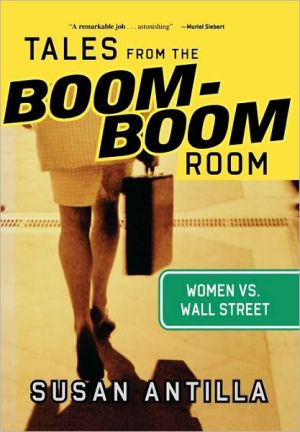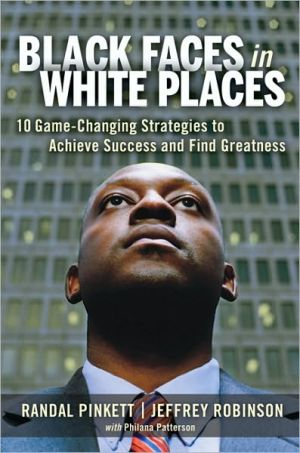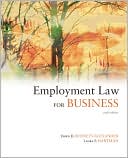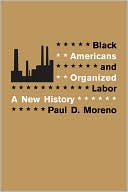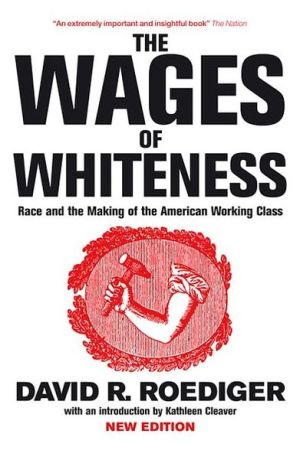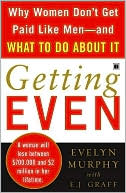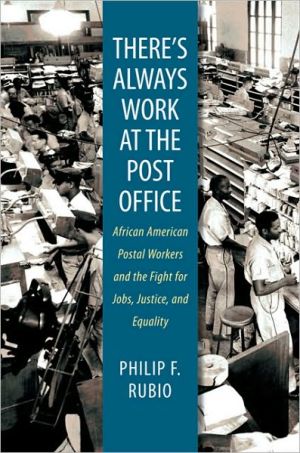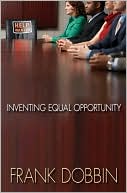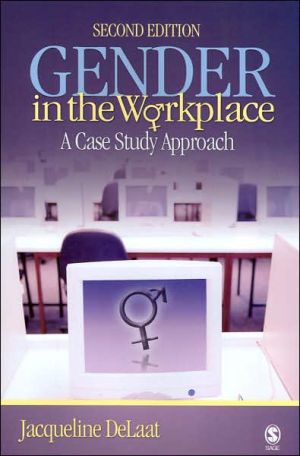Tales from the Boom-Boom Room: Women vs. Wall Street
"As the bull market of the late 1990s soared toward its denouement, America's second-largest brokerage house, Salomon Smith Barney, was hit with a lawsuit that it initially described as having no merit. Three women employees from Garden City, New York, were alleging a pattern of extreme sexual harassment and sex discrimination at their branch office. But they were not to stand alone. A few months later, a similar lawsuit was filed against Merrill Lynch, the nation's biggest brokerage. Soon...
Search in google:
Written by the award-winning reporter who broke the story, this expos is a look inside the sexual misconduct scandals that rocked Wall Street. This is a riveting human, legal, and business drama of men and women in the financial capital of the world. 25 photos. Publishers Weekly This in-depth investigation of the Smith Barney sex scandal and other discrimination against women on Wall Street in the 1990s is an eye-opener. Bloomberg News columnist Antilla deftly tracks the drama and its legal twists and turns, capturing the different points of view while depicting the main characters convincingly. The effect of the lawsuit against Smith Barney was huge, opening a discussion of how women were treated in this male-dominated industry and eventually leading to a watershed change. Antilla begins with the lurid tales from Smith Barney's Garden City, N.Y., basement party room (the so-called "Boom-Boom Room"), where lap dances took place, managers carried guns and men burped, farted and partied with gusto and apparently little self-control. But stories like these were not limited to this one location. Industrywide, many women told similar, recurring tales of how they were intimidated; harassed with X-rated talk; excluded from business lunches, meetings and golf outings; and how their careers were damaged or stymied in various ways. These women put up with devastating behavior far beyond typical locker-room shenanigans; many quit or considered suicide. From Merrill Lynch to Smith Barney, Olde and others, such behavior finally prompted major lawsuits, leading to arbitration and massive media coverage. Antilla expertly untangles the story's many contrasting sides, creating a compelling and disturbing portrait of an industry and the women who dared to challenge it. Photos. (Nov. 14) Forecast: Antilla's book will hit a sore spot with many, and its sensitive contents will probably propel plenty of curious Wall Streeters to pick it up. Copyright 2002 Cahners Business Information.
TALES FROM the BOOM-BOOM ROOM\ WOMEN vs. WALL STREET \ \ By Susan Antilla \ BLOOMBERG PRESS\ Copyright © 2002 Bloomberg, L.P.\ All right reserved.\ ISBN: 1576600785 \ \ \ \ Chapter One\ \ Garden City's Party Spot \ \ Stuff happens on Wall Street and you live with it.\ \ -Patti, a former bond trader\ Wall Street never could help itself when things got good, and in 1982, at the dawn of the greatest bull market in history, it was inevitable that the industry would be gearing up to repeat old mistakes: firms would be hiring too many people, building too many offices, putting on too many fancy parties, and leasing too many stretch limousines.\ In the midst of this rush to expand, though, was a brokerage firm known for an adroit management that could grow its number of offices while somehow controlling its expenses per employee. It was Shearson/ American Express, an empire of investment banking and brokerage operations that was constantly bucking the trends of excess despite a payroll that stood at 14,480 employees by the end of 1982.\ Essential to the profitability of this standout among spendthrifts was its nationwide 352-branch network of retail stock brokerages that fed commissions back to New York headquarters. Investors all over the nation knew the name Shearson and entrusted their money to the company's brokers, who sold them stocks, bonds, commodities, and mutual funds.And a half-hour train ride to the east of New York City, amid a row of brokerage houses in the Long Island town of Garden City, was one celebrity office whose output was among the highest in the system. Lori Hurwitz and Pamela Martens were to receive their harsh introductions to the world of women on Wall Street in the Garden City branch.\ The leading man in Garden City was branch manager Nicholas F. Cuneo. He was from the old guard of Wall Street's retail sales: loud, direct, demanding, and frequently crude in the office, he was accustomed to managing men like himself. Cuneo, five foot nine and slightly overweight, with a little potbelly, had a salt-and-pepper beard to match the salt-and-pepper hair that had largely remained atop his head even as middle age-he was fifty years old in 1982-had bared the pates of his peers. He wore a suit and white shirt each day, removing his jacket as soon as he arrived and not replacing it unless a VIP visited the office or he was leaving for lunch.\ When it came to women, Cuneo possessed a combination of personas. Cuneo the old-fashioned gentleman might show deference to someone who stayed home to tend to her house and her children-roles he sometimes described approvingly to a male broker who reported to him. But Cuneo the manager, suddenly faced with the arrival of women in his workplace, was not so anxious to be deferential.\ Even the setting of the Garden City office seemed to mock the handful of females who worked there, at 901 Franklin Avenue. They came and went each day across the street from a discount ladies' dress store whose sign read "Pay Half." Cuneo had been known to tell women, with more than a little bravado, that they should not expect to be paid as much as the men, some of whom made significantly more than they. Further, they should not even consider trying to sue him. Many had tried and failed, he once bellowed.\ Considering the industry's record, Cuneo could hardly be singled out for underpaying women. Shearson's rival Merrill Lynch had settled a lawsuit in 1976 brought by a woman who'd graduated with honors from Wellesley and had an M.A. in economics from Stanford. Helen O'Bannon, a former college economics instructor whose résumé leading up to her application at Merrill included jobs at the House Banking and Currency Committee, the Treasury Department, and the Comptroller of the Currency, was rejected from the broker training program. O'Bannon took a personality test as part of the application process, answering questions that assumed the applicants would be male.\ "Which quality in a woman do you consider most important?" it asked: "1) beauty 2) intelligence 3) dependency 4) independence or 5) affectionateness?" O'Bannon, who answered "2," got it wrong, because no points were given for intelligence or independence, while two points were given for dependency or affectionateness, and one for beauty. "Dear Mr. O'Bannon," a subsequent letter from Merrill began. "We regret we are unable to take more of the men who apply." Another woman applicant, who also was rejected, had a master's degree, had been director of a business school, and had significant sales experience.\ The four applicants who did make the cut all were male. None of them had earned more than a bachelor's degree. One had dropped out of college because of his poor academic performance. Another previously had worked as a gas station attendant. And two of the four had flunked Merrill's aptitude test.\ So Nicholas Cuneo of Shearson was not alone in thinking that men needed the jobs to cover their big mortgages, or that women should be home with their children. Brokers who worked for him said that Cuneo-like many other Wall Street managers-probably wouldn't have hired women as brokers at all if he had had his way.\ He did, however, distinguish himself by his tendency to be a little louder, a little more vulgar, and even a little more arrogant than his peers in an industry already long on hubris. And he clung to ancient dress codes for women-no pantsuits-even as First Lady Nancy Reagan was wearing knicker pants to the American Embassy in Paris.\ Cuneo was, in short, the king of his branch of Shearson/American Express. Settled on the western end of Long Island, just seventeen miles from Manhattan, Cuneo's office regularly ranked among the top 40 branches out of the more than 400 that Shearson had in those days. With profits fat, his brokers were living the good life, with luxury homes and country club memberships. Cuneo, who hailed from the far more modest Jersey City, New Jersey, now had houses in Port Washington, New York, and Stuart, Florida, an ocean community on Florida's "Treasure Coast."\ Many of the branch's male employees seemed to appreciate the atmosphere he fostered. He would roll up his sleeves and flip burgers in the back parking lot during lunch hour or on a Friday afternoon. Even the clique of women sales assistants with whom he was least popular would join those festivities for a beer and a snack. He once pulled up to the branch at the wheel of a flashy (albeit sputtering and backfiring) red fire engine for a pre-Memorial Day party. And he happily approved the minor expense of T-shirts for the branch softball team, which challenged local brokerage firms and other companies to games at nearby fields. The blue-and-white T-shirts read "Shearson, Etc.," a playful reference to the fact that the acquisitive firm changed names too often to keep up with.\ In the days of the three-martini lunch-and with stocks on an upswing-Nicholas Cuneo was the perfect good-times boss, an inspiration to the partying types working for him. More important, though, Cuneo was a favorite with top management, commanding access as high up as the chairman of the company, Sanford I. "Sandy" Weill, when he needed it. That kind of entrée was valued by Cuneo's staff, who benefited when he used his powerful chits on their behalf.\ A broker who came to Cuneo in the early 1980s with a complaint that his client's huge trade had been mishandled got to watch Cuneo's clout from a front-row seat. While the broker sat in the branch manager's office, Cuneo called Weill for his approval on big expenses that would help smooth things out with the angry customer. Cuneo's finesse and rapport with Weill resulted in an OK for the funds, and he signed off in his classic locker-room style. "Sandy, you're the nicest guy, but fuck you anyway," he said in vulgar but apparently fraternal thanks. The broker was dazzled. If Nick can talk that way to Weill, the broker thought, then Nick and Sandy must be very tight.\ Cuneo had come to Wall Street in 1962, the emergence of an earlier golden age that saw the Dow Jones Industrial Average shoot from a low of 539 in June 1962 to nearly double that by February 1966. He started at the 14 Wall Street office of what was then called Shearson, Hammill & Co., and in 1974 became part of the empire that Sandy Weill was building when Weill's brokerage firm Hayden Stone acquired Shearson Hammfil. Cuneo ultimately was named manager of the Garden City office, and it didn't take long for his branch to rise to the top. Year after year, Cuneo's office ranked in the top 10 percent of all the company branches in profits. By many measures, Garden City deserved its favored status.\ It was a hardworking and hard-partying office surrounded by the trappings of wealth. Cuneo started there when the branch was located at 975 Franklin Avenue, amid a row of competing brokerage house branches that included Prudential Securities, Merrill Lynch, and Charles Schwab & Co. Garden City's little Wall Street was just down the way from Saks Fifth Avenue, along a lane that included Arista Furs and the fine-art store Garden City Galleries. Around the corner, landscape artists carved whimsical animal figures and happy-faces into the shrubs in the town square. It was an affluent location, all right.\ But not so affluent that it was impossible to impress people a little. When word got around the office one day in the early 1980s that Cuneo's newly acquired (albeit secondhand) silver Bentley was parked on the sidewalk outside, even the jaded brokers who owned new Mercedeses came out to lean over and look in.\ Inside the office there was an easygoing dormitory atmosphere; several men jogged to work in the days before running shoes were the stuff of chain stores, and Nick Cuneo put a shower in the basement because, as one of his lieutenants put it, the guys "smelled like billy goats" when they got to the office.\ With Cuneo's encouragement and on their own, his brokers were big revelers. Ducking out for lunch and a drink was not frowned upon in the early 1980s; nor was the idea of decompressing at a local saloon after-hours. Cuneo encouraged a merry atmosphere, ordering in White Castle hamburgers and a keg of beer one afternoon, and barbecuing behind the building on another. Though of Italian heritage, he liked to arrive at the office with corned beef and cabbage to celebrate St. Patrick's Day. (He was said to have cooked the unwieldy feasts at home himself.) And he would occasionally return from an expansive Italian lunch with extra mini-loaves of his favorite garlic bread to pass out to his friends. Cuneo kept an assortment of candies in his office in case someone stopped by; if the visitor was a favorite, he'd break out the booze he kept on hand.\ Just about everybody loved Cuneo, because he believed in fun and he believed in having his staff, mostly male heads of households, make money. Big money was spent on entertainment, too. Cuneo's lavish Christmas gathering was considered the hot ticket of the season even by the sophisticates at Shearson headquarters in New York. For his Halloween parties, even he would dress up: once Cuneo came as a piece of gold bullion.\ With the reveling, though, came the outrageous, and Cuneo's old-school, boys-will-be-boys approach abetted an environment where things could cross the line. Male brokers howled as a strip-o-gram was delivered for all in the branch to see. Female brokers-always in the minority-were quickly dubbed with degrading nicknames: "Slits and Tits" was one that especially irked the female staff. Cuneo's shouting, his crass language, and his anti-Semitic remarks made all but the most hardened brokers cringe. There were decent men in Cuneo's office who wanted to work hard and get the job done. Some were conflicted about what they heard. Others didn't like Cuneo's language in front of women but agreed with him that women should be at home. It was a time when men in branch offices of brokerage firms were encountering significant numbers of female colleagues for the first time. For some of them, it was unsettling.\ Leslie Frutkin, one of the first women to work as a broker in Garden City, was inclined to like the boss's wild style when she arrived at age twenty-five in 1982. As far as she was concerned, Nick was a lot of fun, providing opportunities for staff to let off steam at a high-stress job. Frutkin, though, was a protected species relative to the handful of other women, having known Cuneo-a family friend-since she was a child. But even she was shocked to see Cuneo slam things, throw things, scream, and curse. That behavior was apparently contagious. In the early 1980s, the office was encouraging small investors to get into commodities trading, and one broker who was there at the time remembers that visiting clients sometimes got into fistfights with one another over their strategies.\ For all the atmosphere of madness he established at the office, Cuneo was appreciated for a softer side. His workdays ended with a ten-mile ride home to attend to his wheelchair-bound wife, Caroline, who had for years suffered from multiple sclerosis. (In later years, he would be on the receiving end of compassion when he developed heart problems.) Caroline was well-liked even by the boss's fiercest enemies, praised for her gentle demeanor and her grace in the face of a debilitating illness. Hospice of Long Island depended heavily on Cuneo's personal and financial support. Employees knew that Cuneo would lend an ear-and perhaps even a desk if a relative desperately needed work.\ The brokers watched Cuneo dote on Caroline when she came for company parties, though he made no effort to censor his salty tongue in front of her. One employee was aghast when, at the first office Christmas party she attended, Cuneo with microphone in hand told the gathered staff that one of the male brokers was a "faggot." Another year, he told employees at a holiday party at Zachary's Disco in East Meadow that the previous twelve months' success had gained them notoriety as "the biggest whorehouse in Garden City." Still, his Dr. Jekyll aspect also could be seen: He bought the house in Florida so that Caroline would have a more comfortable place to spend the cold Northeastern winters, one of his supporters said. When he bought a van and the silver Bentley, the supporter speculated that he did so in order to allow Caroline to get in and out of the vehicles as easily as possible when she had to travel.\ As a larger-than-life local dignitary, Cuneo reaped the rewards of his position in Garden City circles. When he parked the Bentley on the sidewalk behind the branch, staffers never saw a parking ticket on it. When smoke billowed above the Franklin Avenue parking lot during Cuneo's barbecues, nobody complained to the fire department. In fact, the police occasionally stopped by for a hamburger.\ Nicholas Cuneo usually got his way, and had the bottom-line results to justify it. He didn't need any pushy females trying to tell him how to run his office.\ \ Continue...\ \ \ \ Excerpted from TALES FROM the BOOM-BOOM ROOM by Susan Antilla Copyright © 2002 by Bloomberg, L.P.\ Excerpted by permission. All rights reserved. No part of this excerpt may be reproduced or reprinted without permission in writing from the publisher. \ \
AcknowledgmentsPrefacePrologue11Garden City's Party Spot52From Appalachia to Wall Street173Wild Times for Wall Street274Nick's Way with Women395Martens's Disorienting Orientation556Martens Snaps777That Was Happening to You, Too?878Dear Mr. Dimon: Martens Fights Back1099Getting Lawyers. Getting Fired12310Attacking the No-Court System13711Going Public16112Momentum: Merrill's Women Sue17113Martens Without Martens19714Settling the Settlement21715Pariah or Visionary?24316Arbitration After All271Epilogue291Notes295Index331
\ From Barnes & NobleBloomberg News columnist Susan Antilla has been investigating Wall Street's history of sexual harassment since 1995. Her Tales from the Boom-Boom Room (which borrows its title from Smith Barney's infamous basement party room) isn't just a collection of water-cooler rumors; it's a high-intensity narrative that exposes thousands of appalling cases of sexual harassment and abuse of power in brokerage firms from coast to coast.\ \ \ \ \ Publishers WeeklyThis in-depth investigation of the Smith Barney sex scandal and other discrimination against women on Wall Street in the 1990s is an eye-opener. Bloomberg News columnist Antilla deftly tracks the drama and its legal twists and turns, capturing the different points of view while depicting the main characters convincingly. The effect of the lawsuit against Smith Barney was huge, opening a discussion of how women were treated in this male-dominated industry and eventually leading to a watershed change. Antilla begins with the lurid tales from Smith Barney's Garden City, N.Y., basement party room (the so-called "Boom-Boom Room"), where lap dances took place, managers carried guns and men burped, farted and partied with gusto and apparently little self-control. But stories like these were not limited to this one location. Industrywide, many women told similar, recurring tales of how they were intimidated; harassed with X-rated talk; excluded from business lunches, meetings and golf outings; and how their careers were damaged or stymied in various ways. These women put up with devastating behavior far beyond typical locker-room shenanigans; many quit or considered suicide. From Merrill Lynch to Smith Barney, Olde and others, such behavior finally prompted major lawsuits, leading to arbitration and massive media coverage. Antilla expertly untangles the story's many contrasting sides, creating a compelling and disturbing portrait of an industry and the women who dared to challenge it. Photos. (Nov. 14) Forecast: Antilla's book will hit a sore spot with many, and its sensitive contents will probably propel plenty of curious Wall Streeters to pick it up. Copyright 2002 Cahners Business Information.\ \ \ Financial Times"A gutsy, important book"\ \ \ \ \ BusinessWeek"Comprehensive and sharply written"\ \
